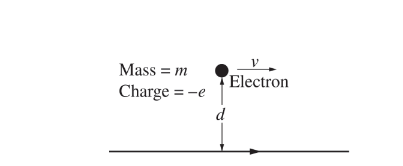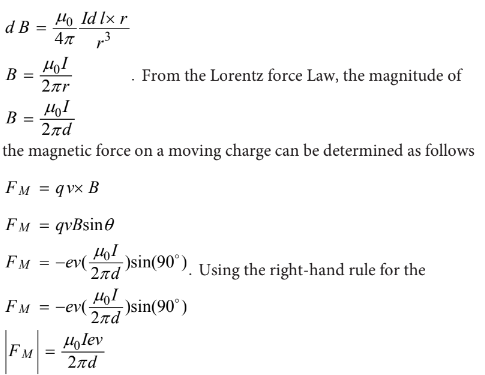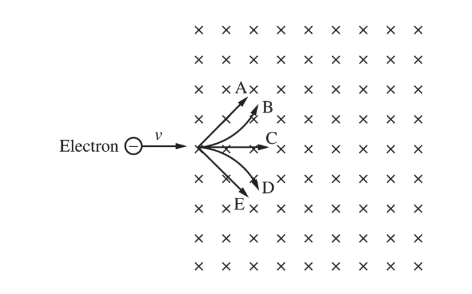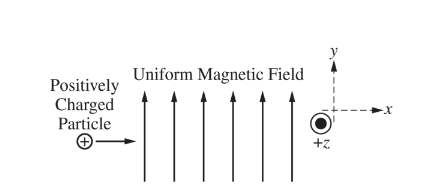Question

An electron of mass m and charge -e is traveling to the right parallel to a wire with speed v . The electron is a distance d from the wire. The wire is carrying a current I to the right, as shown in the figure above. Which of the following gives the magnitude and direction of the force exerted on the electron by the current-carrying wire?
Magnitude Direction
(A) \(\frac{\mu _{0}Iev}{2\pi d} \) Toward the top of the page
(B) \(\frac{\mu _{0}Iev}{2\pi d} \) Out of the page
(C) \(\frac{\mu _{0}Iev}{2\pi d} \) Into the page
(D) \(\frac{\mu _{0}Iev}{2m\pi d} \) Toward the top of the page
(E)\(\frac{\mu _{0}Iev}{2m\pi d} \) Out of the page
Answer/Explanation
Ans:A
First, the magnitude of the magnetic field B, which is due to the current carrying wire, can be determined using the Biot-Savart Law, where -e is the charge and is the velocity of the charge. Thus, the magnetic field for this straight wire, where d is also the perpendicular distance from the charge to the wire, is as follows

Question

An electron is traveling with speed v when it enters a uniform magnetic field that is directed into the page, as shown above. Five paths in the magnetic field are labeled A, B, C, D, and E.
Which labeled path best shows the path the electron will follow as it travels through the magnetic field?
(A) Path A
(B) Path B
(C) Path C
(D) Path D
(E) Path E
Answer/Explanation
Ans:D Using the right-hand rule for the magnetic force (from the Lorentz force equation), \(\vec{F}=\vec{qv}\times \vec{B}\) the direction of velocity to the right crossed with the magnetic field perpendicular and into the page results in a magnetic force acting on the moving charge up toward the top of the page. However, since the charge is negative, the direction of the magnetic force acts down on the electron. Since force is being applied to the electron as soon as it enters the B field, it begins accelerating due the relationship \(\vec{F}=m\vec{a}\) Since the electron
is accelerating, the path that the electron deflects down is not linear
Question

An electron is traveling with speed v when it enters a uniform magnetic field that is directed into the page, as shown above. Five paths in the magnetic field are labeled A, B, C, D, and E.
The electron is replaced with a proton that is traveling at the same speed v in the same direction as it enters the magnetic field. Which of the following best describes the motion of the proton as it passes through the magnetic field?
I. The speed of the proton changes less than the speed of the electron did.
II. The proton is deflected in the opposite direction.
III. The proton is deflected more than the electron.
(A) I only
(B) I and II only
(C) II only
(D) II and III only
(E) I, II and III
Answer/Explanation
Question
A positively charged particle moves in the positive x-direction in a uniform magnetic field directed in the positive y-direction. The net force on the particle could be zero if there is also an electric field present in the
(A) positive z-direction
(B) negative z-direction
(C) positive x-direction
(D) negative x-direction
(E) negative y-direction

